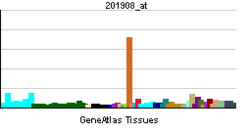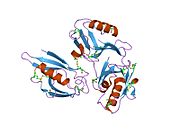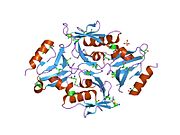- DVL3
-
Segment polarity protein dishevelled homolog DVL-3 is a protein that in humans is encoded by the DVL3 gene.[1][2]
This gene is a member of a multi-gene family which shares strong similarity with the Drosophila dishevelled gene, dsh. The Drosophila dishevelled gene encodes a cytoplasmic phosphoprotein that regulates cell proliferation.[2]
Contents
Interactions
DVL3 has been shown to interact with DAB2,[3] DVL1[4] and PRPF3.[5]
See also
References
- ^ Pizzuti A, Amati F, Calabrese G, Mari A, Colosimo A, Silani V, Giardino L, Ratti A, Penso D, Calza L, Palka G, Scarlato G, Novelli G, Dallapiccola B (Jan 1997). "cDNA characterization and chromosomal mapping of two human homologues of the Drosophila dishevelled polarity gene". Hum Mol Genet 5 (7): 953–8. doi:10.1093/hmg/5.7.953. PMID 8817329.
- ^ a b "Entrez Gene: DVL3 dishevelled, dsh homolog 3 (Drosophila)". http://www.ncbi.nlm.nih.gov/sites/entrez?Db=gene&Cmd=ShowDetailView&TermToSearch=1857.
- ^ Hocevar, B A; Mou F, Rennolds J L, Morris S M, Cooper J A, Howe P H (Jun. 2003). "Regulation of the Wnt signaling pathway by disabled-2 (Dab2)". EMBO J. (England) 22 (12): 3084–94. doi:10.1093/emboj/cdg286. ISSN 0261-4189. PMC 162138. PMID 12805222. http://www.pubmedcentral.nih.gov/articlerender.fcgi?tool=pmcentrez&artid=162138.
- ^ Kishida, S; Yamamoto H, Hino S, Ikeda S, Kishida M, Kikuchi A (Jun. 1999). "DIX domains of Dvl and axin are necessary for protein interactions and their ability to regulate beta-catenin stability". Mol. Cell. Biol. (UNITED STATES) 19 (6): 4414–22. ISSN 0270-7306. PMC 104400. PMID 10330181. http://www.pubmedcentral.nih.gov/articlerender.fcgi?tool=pmcentrez&artid=104400.
- ^ Rual, Jean-François; Venkatesan Kavitha, Hao Tong, Hirozane-Kishikawa Tomoko, Dricot Amélie, Li Ning, Berriz Gabriel F, Gibbons Francis D, Dreze Matija, Ayivi-Guedehoussou Nono, Klitgord Niels, Simon Christophe, Boxem Mike, Milstein Stuart, Rosenberg Jennifer, Goldberg Debra S, Zhang Lan V, Wong Sharyl L, Franklin Giovanni, Li Siming, Albala Joanna S, Lim Janghoo, Fraughton Carlene, Llamosas Estelle, Cevik Sebiha, Bex Camille, Lamesch Philippe, Sikorski Robert S, Vandenhaute Jean, Zoghbi Huda Y, Smolyar Alex, Bosak Stephanie, Sequerra Reynaldo, Doucette-Stamm Lynn, Cusick Michael E, Hill David E, Roth Frederick P, Vidal Marc (Oct. 2005). "Towards a proteome-scale map of the human protein-protein interaction network". Nature (England) 437 (7062): 1173–8. doi:10.1038/nature04209. PMID 16189514.
Further reading
- Nagase T, Seki N, Ishikawa K, et al. (1997). "Prediction of the coding sequences of unidentified human genes. VI. The coding sequences of 80 new genes (KIAA0201-KIAA0280) deduced by analysis of cDNA clones from cell line KG-1 and brain". DNA Res. 3 (5): 321–9, 341–54. doi:10.1093/dnares/3.5.321. PMID 9039502.
- Semënov MV, Snyder M (1997). "Human dishevelled genes constitute a DHR-containing multigene family". Genomics 42 (2): 302–10. doi:10.1006/geno.1997.4713. PMID 9192851.
- Bui TD, Beier DR, Jonssen M, et al. (1997). "cDNA cloning of a human dishevelled DVL-3 gene, mapping to 3q27, and expression in human breast and colon carcinomas". Biochem. Biophys. Res. Commun. 239 (2): 510–6. doi:10.1006/bbrc.1997.7500. PMID 9344861.
- Kishida S, Yamamoto H, Hino S, et al. (1999). "DIX domains of Dvl and axin are necessary for protein interactions and their ability to regulate beta-catenin stability". Mol. Cell. Biol. 19 (6): 4414–22. PMC 104400. PMID 10330181. http://www.pubmedcentral.nih.gov/articlerender.fcgi?tool=pmcentrez&artid=104400.
- Song DH, Sussman DJ, Seldin DC (2000). "Endogenous protein kinase CK2 participates in Wnt signaling in mammary epithelial cells". J. Biol. Chem. 275 (31): 23790–7. doi:10.1074/jbc.M909107199. PMID 10806215.
- Strausberg RL, Feingold EA, Grouse LH, et al. (2003). "Generation and initial analysis of more than 15,000 full-length human and mouse cDNA sequences". Proc. Natl. Acad. Sci. U.S.A. 99 (26): 16899–903. doi:10.1073/pnas.242603899. PMC 139241. PMID 12477932. http://www.pubmedcentral.nih.gov/articlerender.fcgi?tool=pmcentrez&artid=139241.
- Hocevar BA, Mou F, Rennolds JL, et al. (2003). "Regulation of the Wnt signaling pathway by disabled-2 (Dab2)". EMBO J. 22 (12): 3084–94. doi:10.1093/emboj/cdg286. PMC 162138. PMID 12805222. http://www.pubmedcentral.nih.gov/articlerender.fcgi?tool=pmcentrez&artid=162138.
- Ota T, Suzuki Y, Nishikawa T, et al. (2004). "Complete sequencing and characterization of 21,243 full-length human cDNAs". Nat. Genet. 36 (1): 40–5. doi:10.1038/ng1285. PMID 14702039.
- Torban E, Wang HJ, Groulx N, Gros P (2005). "Independent mutations in mouse Vangl2 that cause neural tube defects in looptail mice impair interaction with members of the Dishevelled family". J. Biol. Chem. 279 (50): 52703–13. doi:10.1074/jbc.M408675200. PMID 15456783.
- Gerhard DS, Wagner L, Feingold EA, et al. (2004). "The status, quality, and expansion of the NIH full-length cDNA project: the Mammalian Gene Collection (MGC)". Genome Res. 14 (10B): 2121–7. doi:10.1101/gr.2596504. PMC 528928. PMID 15489334. http://www.pubmedcentral.nih.gov/articlerender.fcgi?tool=pmcentrez&artid=528928.
- Rual JF, Venkatesan K, Hao T, et al. (2005). "Towards a proteome-scale map of the human protein-protein interaction network". Nature 437 (7062): 1173–8. doi:10.1038/nature04209. PMID 16189514.
- Chan DW, Chan CY, Yam JW, et al. (2006). "Prickle-1 negatively regulates Wnt/beta-catenin pathway by promoting Dishevelled ubiquitination/degradation in liver cancer". Gastroenterology 131 (4): 1218–27. doi:10.1053/j.gastro.2006.07.020. PMID 17030191.
PDB gallery Categories:- Human proteins
- Chromosome 3 gene stubs
Wikimedia Foundation. 2010.




